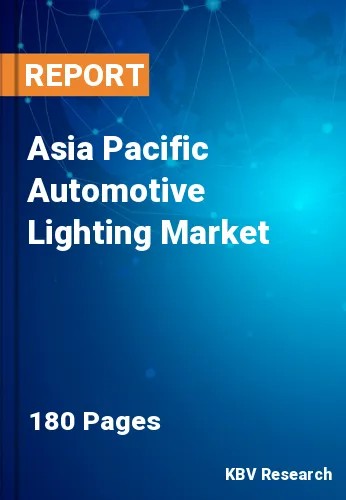The Asia Pacific Automotive Lighting Market would witness market growth of 7.5% CAGR during the forecast period (2023-2030). In the year 2021, the Asia Pacific market's volume surged to 733.2 million units, showcasing a growth of 7.5% (2019-2022).
LED lighting systems, already prevalent in signal lighting applications, have been implemented in forward headlamp systems. The ongoing progressions in luminosity efficiency will further enhance their appeal for implementation in automotive applications. Intensity control via current modulation or pulse width modulation, modular configurations, and the solid-state construction of LED systems offer considerable potential for energy-efficient vehicle lighting systems capable of real-time adaptation to fluctuating weather conditions and roadway traffic. Adaptive headlamp systems, in which the luminosity can be adjusted in response to approaching or preceding vehicles, are a perfect application for LEDs.
Extreme weather conditions and escalating nighttime motorist safety concerns are the primary factors propelling the demand for energy-efficient and technologically advanced lighting sources. Conventional lighting sources consume approximately 20% of the total power, whereas end consumers could save up to 40% of energy annually by using LED lighting. Government initiatives concerning CO2 emissions from vehicles serve as an additional impetus for manufacturers to incorporate LED lighting sources into their cars.
According to the India Brand Equity Foundation, India holds a prominent position in the international heavy vehicle industry, being the foremost producer of tractors, the second-largest manufacturer of buses, and the third-largest manufacturer of heavy trucks. Additionally, nations like Japan are developing electric vehicle technology extensively, and the sales of EVs are rising. According to the Japan Automobile Dealers Association (JADA), nearly 1.4 million new electric vehicles were sold in 2020. Therefore, factors like high car production and advancements in new technologies are the driving forces for the regional market.
The China market dominated the Asia Pacific Automotive Lighting Market, By Country in 2022, and would continue to be a dominant market till 2030; thereby, achieving a market value of $5,716.1 Million by 2030. The Japan market is registering a CAGR of 6.7% during (2023 - 2030). Additionally, The India market would showcase a CAGR of 8.1% during (2023 - 2030).
Based on Position, the market is segmented into Front Lighting, Back Lighting, Side Lighting, and Interior Lighting. Based on Vehicle Type, the market is segmented into Passenger Vehicle, Commercial Vehicle, and Electric Vehicle. Based on Technology, the market is segmented into LED, Halogen and Xenon. Based on Sales Channel, the market is segmented into Aftermarket and OEM. Based on countries, the market is segmented into China, Japan, India, South Korea, Singapore, Malaysia, and Rest of Asia Pacific.
Free Valuable Insights: The Global Automotive Lighting Market is Predict to reach $56.6 Billion by 2030, at a CAGR of 7.1%
The market research report covers the analysis of key stake holders of the market. Key companies profiled in the report include Koninklijke Philips N.V., General Electric Company, ams-OSRAM AG, Valeo SA, Stanley Electric Co. Ltd., LG Electronics, Inc. (LG Corporation), KOITO MANUFACTURING CO., LTD, HELLA GmbH & Co. KGaA, Marelli Holdings Co., Ltd. and Robert Bosch GmbH
By Position (Volume, Million Units, Revenue, USD Billion/Millon, 2019-30)
By Vehicle Type (Volume, Million Units, Revenue, USD Billion/Millon, 2019-30)
By Technology (Volume, Million Units, Revenue, USD Billion/Millon, 2019-30)
By Sales Channel (Volume, Million Units, Revenue, USD Billion/Millon, 2019-30)
By Country (Volume, Million Units, Revenue, USD Billion/Millon, 2019-30)
Our team of dedicated experts can provide you with attractive expansion opportunities for your business.

